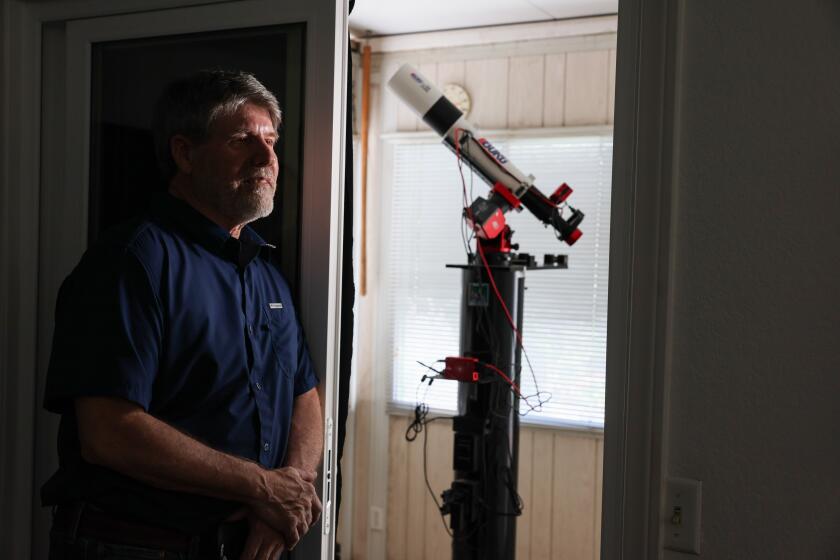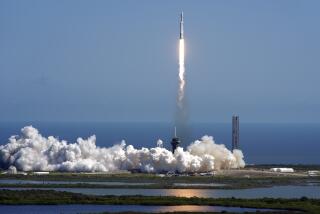Scientists long urged NASA to search for signs of life near Jupiter. Now it’s happening

- Share via
- Jupiter’s icy moon Europa is suspected of harboring a vast ocean that may be capable of supporting life.
- The $5-billion Europa Clipper spacecraft is the largest interplanetary probe ever built by NASA.
- The probe will launch on a SpaceX rocket, built in Hawthorne.
- At the end of its mission, the probe is scheduled to intentionally slam into Jupiter’s rocky moon Ganymede.
In 2015, Bill Nye was on Marine One with President Obama.
The television personality and science advocate was officially there for an Earth Day event, but he took the opportunity to talk to the president about space exploration — and specifically, a mission still in its infancy at NASA’s Jet Propulsion Laboratory in La Cañada Flintridge that desperately needed funds.
After a decade of advocacy from scientists, the mission is expected to launch as early as Friday, and will investigate Jupiter’s icy moon Europa, which is believed to harbor a vast ocean capable of supporting life.
“There are two questions: Where did we come from? And, are we alone in the universe?” Nye said. “If you meet somebody who says he or she never asks those questions, they’re not being honest with you.”
Scientists say microscopic black holes could explain the elusive “dark matter” that makes up a quarter of all matter in the universe. But can it be proven?
Engineered by JPL, the $5-billion Europa Clipper spacecraft is the largest interplanetary probe ever built by the space agency. The probe will launch on a SpaceX rocket, built in Hawthorne.
“If we find life on another world, it will change life on this one,” Nye said. “It’s the people who live and work in Los Angeles County who do this work that potentially will change the course of human history.”
On the heels of the James Webb Space Telescope and Perseverance Mars Rover, Clipper is one of the last multibillion-dollar “flagship” projects to squeeze through development this decade as NASA faces budget tightening and project management issues.
“I often talk about these missions as modern cathedrals. They are generational quests,” NASA JPL Director Laurie Leshin said at a news conference for the Clipper launch. “I’m really proud that, as humanity, we choose to undertake these difficult and long-term goals — things like exploring the unknown out at Jupiter.”
NASA has until Nov. 6 to launch the probe and is currently waiting for Hurricane Milton to pass over Florida’s Space Coast.
Once the spacecraft leaves its Cape Canaveral launchpad, it begins a five-and-a-half-year odyssey — first sling-shotting around Mars in early 2025, and then boomeranging back around Earth in late 2026 before it speeds toward the solar system’s largest planet and an incredibly dynamic moon.
Europa orbits Jupiter in just three and a half days, traveling 10 times faster than our moon. The intense gravitational forces from the gas giant constantly crush and strain the moon’s core, heating it up.
Scientists believe hydrothermal water vents blast the core’s heat upward, thawing an expansive ocean that sloshes roughly 15 miles below the moon’s icy crust — far deeper than humans have ever dug on Earth.
Observations from Earth and orbiting probes suggest that some of this water works through fissures in the ice and blasts through in geysers more than a hundred miles high.
With liquid water and a source of energy in the form of heat, Europa has fascinated scientists for decades. If it also harbors organic compounds such as amino acids, which form the proteins that make up cells, then Europa could be home to alien life-forms.
With a rare star explosion expected any day now, astrophysicists are relying on a community of hobbyists with backyard telescopes to tell them when it erupts.
Clipper will search for light signatures of these compounds on Europa — and any that may be blasted into space by meteorites or geysers.
“If there is something alive — imagine a Europanian microbe, let alone Europanian fish people — these things would be shot into space,” Nye said. “If you sample water in any pond anywhere on Earth, anywhere there’s moisture, you’ll find all these viruses and bacteria and microbes, writ tiny, and so it’s reasonable we’d at least find organic compounds.”
(NASA is virtually certain it won’t find fish people, but that hasn’t stopped scientists from dreaming.)
Previous missions to Jupiter have given scientists a rough sketch of the moon, but Clipper will help paint a detailed portrait.
Once Clipper arrives at Jupiter, it will orbit the gas giant 80 times over the course of four years, making 49 Europa flybys, as close as 16 miles from the surface, to collect data from pole to pole.
Within its first few flybys, scientists should be able to confirm the existence of the ocean — all by reading the magnetic field produced by the moon and measuring its gravity by determining how much it pulls the spacecraft.
They’ll also get some of the highest-resolution images ever taken of the moon and the first readings of which molecules lie near the surface.
Throughout the rest of the mission, Clipper will study the complex dynamics of how the ocean interacts with the icy crust and heated mantle below. This will slowly come into view as the probe uses penetrating radio waves to peer beneath the icy crust — much like an X-ray machine.
“Clipper is going to be the first in-depth mission that will allow us to characterize habitability on what could be the most common type of inhabited world in our universe,”Gina Dibraccio, acting director of NASA HQ’s Planetary Science Division, said at a news conference.
On Sept. 3, 2034, Europa Clipper will intentionally slam into Jupiter’s rocky moon Ganymede, ensuring the spacecraft doesn’t accidentally strike one of the planet’s more scientifically interesting moons.
That is, unless NASA decides to extend the mission, which has frequently happened in the past.
Clipper isn’t the first mission to explore the icy moon. The Galileo probe flew past it in the 1990s, confirming scientists’ hopes that the moon was more than the quiet rocky ball orbiting Earth.
The excitement led scientists to formally ask NASA for a dedicated Europa mission in the early 2000s.
But NASA always has to weigh the potential scientific discoveries of bold flagship missions against the risk of cost overruns, and back then, the agency had cold feet.
Caltech has retired a telescope atop the summit of Hawaii’s Mauna Kea following a cultural sea change in how people view land development on revered landmarks.
By 2013, NASA had just finished dealing with cost overruns on the Curiosity Mars Rover and the agency was focused on getting the James Webb Space Telescope into space. All while Congress had slashed its planetary science budget almost in half compared with a decade prior.
So, the Science Guy got involved.
“We realized that this [mission] would be possible 10 years ago at the Planetary Society,” Nye said, “and so we just got on it: ‘Look, everybody, write letters, write emails, talk with your congressmen, come to our days of action.’”
The Planetary Society, a Pasadena-based nonprofit of which Nye is the chief executive and a longtime member, decided to throw its weight behind a Europa mission. Its leadership testified before Congress and spoke on Capitol Hill. Planetary Society members wrote more than 375,000 messages of support to Congress and the White House.
In 2014, NASA explicitly told scientists and Congress that it would not fund a Europa mission in its budget request.
“That never happens,” said Casey Dreier, the chief of space policy at the Planetary Society. “They never just put in a budget request, ‘We’re not going to do something. There’s no money. Basically, please stop asking.’”
But by the next year, NASA had asked Congress for $15 million to start the multibillion-dollar probe. A congressman from Texas who was a champion for space funding — and also held power in the budget process — helped secure $100 million for the project.
NASA selected JPL to design and build the spacecraft.
“It’s not too surprising to see JPL win a contract for a planetary mission,” said Matthew Shindell, planetary science and exploration curator at the Smithsonian National Air and Space Museum.
“They really do have an incredible track record,” he said. “So, they’re one of NASA’s most trusted centers when it comes to developing large robotic missions.”
Today, with inflation further flattening NASA’s budget and the high cost of its current focus — human spaceflight — there’s another slump in large, strategic science missions. That has also created hardships for JPL.
In September, an investigation ordered by Congress found that NASA was neglecting critical long-term investments in infrastructure and workforce to instead fund expensive missions.
With Clipper leaving Earth, the remaining future flagship missions are either in their infancy or embroiled in financial and management woes.
That leaves JPL with few major projects to keep funding flowing to its more than 5,000 employees. Clipper engineering operations are winding down and NASA HQ severely shuttered its other flagship program, the Mars sample return, due to high projected costs and delays.
Flagship funding and concerns about cost overruns have ebbed and flowed at NASA for decades — and JPL’s future along with it.
In the 1980s, JPL was barely clinging to life as the Reagan administration pondered spinning off the lab as a private institution and canceling its only flagship mission: Galileo.
The ordeal inspired the founding of the Planetary Society.
Luckily, a trustee at Caltech, which manages JPL, knew the U.S. Senate majority leader, effectively saving the lab and the Galileo mission that would go on to revolutionize scientists’ understanding of Europa and inspire the Clipper mission.
“Sometimes it really comes down to finding a champion” — not only a supporter, but someone with the power to actually move money, Dreier said. “And right now JPL doesn’t have one.”










